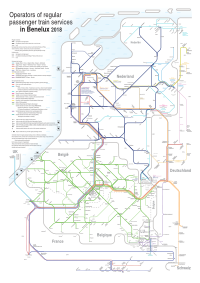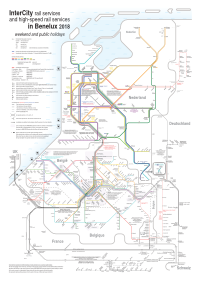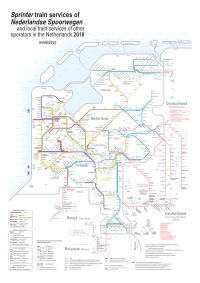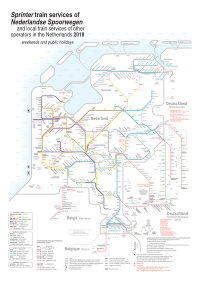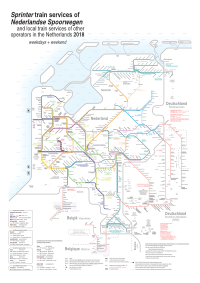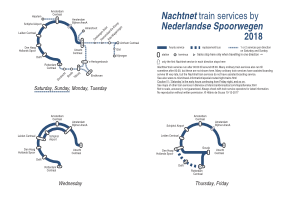Travelling around Benelux by train: general tips
Greetings! Here are some tips on train travel in/to/from/through Benelux. Belgium laid the first modern railway in Continental Europe in 1835 (Netherlands laid its first in 1839, and Luxembourg in 1845). The three countries have well developed railway networks, connecting the vast majority of towns and cities. Within Benelux, rail is the fastest – and certainly the most convenient – way to travel between many larger cities.
Press the menu buttons for tips on train travel specific to each country; tips in this home page and tips in the individual country pages overlap only partially. Below are the network maps that I have drawn for the regular passenger train services in Benelux in 2018; they are repeated in the country-specific pages, with further comments. Due to the complexity of the networks, especially that of Belgium, I have opted to not present everything in one map. (Click on the thumbnails to open the pdf's.)
General overview of the passenger train operators and their networks in Benelux in 2018:
InterCity and high-speed rail network in Benelux:
Local train network in the Netherlands
(there is not much difference between the weekday and weekend networks, so there is a combined weekdays+weekend map):
Nachtnet in the Netherlands (domestic night trains between some larger cities):
Regular local train network in Belgium and Luxembourg:
Supplementary train network in Belgium:
Here are videos of the types of passenger rail services in Benelux that I made:
The following are some notes on train travel in Benelux in general. (See also the country-specific pages!)
Jump to:
Ticketing matters
The national railway companies in the region
The national railway companies in Benelux:
- Netherlands: NS (domestic website, android, android wear, iOS; international website, android, iOS)
- Belgium: NMBS/SNCB (domestic website, android, iOS; international website, android, iOS)
- Luxembourg: CFL (website; android, iOS; international website for France, international booking page for other countries)
The national railway companies of countries that you can reach directly from Benelux (by regular passenger rail services):
- France: SNCF (website, android, iOS)
- Germany: DB (website, android, iOS)
- Great Britain: National Rail (website, android, iOS, Windows)
- Switzerland: SBB/CFF/FFS (website, android, iOS)
(National Rail of Great Britain is not one company; it is a brand of an association of companies.)
The 'domestic' sites are for train travels within their respective countries, and the 'international' sites are for international train travels. There are multiple railway companies running domestic train services in Benelux, especially the Netherlands; the domestic sites of NS, NMBS/SNCB, and CFL can handle any regular train journeys within their countries, even on services not run by them. With international train travels, different companies can give different prices for the same international journey, so it is worth checking the booking websites of the various countries. For international journeys that involve train changes, it is worth comparing the price of making one booking for the entire journey, versus dividing the journey into various bookings.
Do I have to book early for the best price?
- Yes, dynamic pricing on basically all high-speed rail services, IC/EC in Germany, and Intercités in France (price of tickets for immediate deparature can range from very expensive to still quite cheap, depending on demand):
- Eurostar: high-speed England – France – Belgium; England – Belgium – the Netherlands, England – France.
- Thalys: high-speed France – Belgium – The Netherlands; France – Belgium – Germany.
- IZY: low-cost Paris – Brussels, half on high-speed rail, half on conventional rail.
- OUIGO: low-cost high-speed France domestic.
- TGV: high-speed Brussels – France, Luxembourg – France, France domestic, etc.
- Intercités: France domestic.
- ICE (high-speed), IC or EC (non-high-speed) in/from/to/through Germany (the umbrella term for these in German is Fernverkehr 'long-distance traffic').
- Flixtrain: low-cost Germany domestic.
- Yes-ish, fixed prices that disappear some days before departure:
- Non-high-speed rail travel (including Intercity direct) between the Netherlands and Belgium, or between the Netherlands and Luxembourg via Belgium: fixed discount available 7 or more days before departure, on average 40% off for Mon–Thurs, 20% off for Fri–Sun. In practical terms, with NS and NMBS/SNCB, this is an internet-only fare; other channels of purchase either do not provide discounted tickets, or charge hefty booking fees.
- Eurostar from Brussels-Midi/Zuid to Lille Europe or Calais Fréthun (in this direction only): must be booked two or more days before departure, and can only be booked through the NMBS/SNCB International or Belgian Eurostar website/app. (For Lille, TGV and Thalys are more flexible anyway, and are sometimes cheaper.)
- No:
- ICE within the Netherlands: domestic ticketing plus a surchage of €2.4, for most people.
- ICE within Belgium: domestic ticketing plus a surcharge of €8 second class, €12 first class.
- Intercity direct (ICd) within the Netherlands: domestic ticketing with a surcharge of €2.4 on the Schiphol Airport – Rotterdam Centraal high-speed line.
- InterCity within the Netherlands, InterCity in Belgium+Luxembourg, InterCity between Belgium and Lille. (IC in Benelux have the same pricing as local trains; this is unlike Germany and France.)
- Other non-high-speed trains in Benelux: Sneltrein/Stoptrein/Sprinter in the Netherlands, S/L/P/ICT in Belgium, RE/RB in Luxembourg.
- Non-high-speed tickets issued by NMBS/SNCB for just between Roosendaal and Belgium, and just between Maastricht and Belgium.
- IRE, RE, RB, S-bahn in Germany, including local trains between Benelux and Germany (the umbrella term for these in German is Nahverkehr 'near traffic').
- TER, TERGV, and Transilien in France, including TER to/from Luxembourg.
Other than the ICE and ICd surcharges mentioned above, the only other surcharge is the Diabolo fee: station access fee for Brussels Airport-Zaventem station.
Seats on high-speed trains are sometimes overbooked to a small degree. However, unlike air tickets, they tell you that you're sold an overbooked ticket before you make the payment. If you agree to it and pay, your ticket has an assigned carriage, but not a seat number. Contact the train manager when you board the train: if someone in your carriage fails to turn up, you may be assigned their seat; if there are no empty seats, you sit on a folding seat / jump seat.
For non-high-speed rail services, the price of a return ticket is usually just the sum of the one-way journeys involved, except for a few international return deals from Belgium or Luxembourg, and Luxembourg's time-based domestic tickets. For high-speed rail services, sometimes there are special return deals.
See the pages of the individual countries for more details.
Do I have to make a seat reservation? / Do I have to catch a specific train?
- Compulsory seat reservation: Eurostar, Thalys, TGV, long-distance and night Intercités in France (see the map in the Intercités page: light green lines and hollow lines). You must catch the specific train as stated in the ticket.
- Compulsory seat assignment: IZY, OUIGO. (They assign you a seat; you have no choice.)
- Optional seat reservation: ICE/IC/EC in/to/from/through Germany; seat reservation is optional in second class, included in first class. Sparpreis tickets restrict you to the particular ICE/IC/EC trains or IC bus as stated on the ticket; Flexpreis tickets are flexible and are valid for: a) one day for journeys under 100km within Germany; b) two days for journeys longer than 100km within Germany (the printed date and the following day); and c) four days for international journeys. Sparpreis can run out; Flexpreis do not run out.
- Some have seat assignment included, some have no reservation possible: short distance Intercités in France (see the map in the Intercités page: dark green lines). Intercités tickets usually restrict you to particular train services.
- No seat reservation possible: other trains, including Intercity direct between the Netherlands and Belgium, and local train services. You can use the ticket on any service(s) along the designated route for a single or return journey within the date printed on the ticket.
- Flixtrains have no seat servations. (But do their night trains have reserved beds?)
Do I have to validate my ticket?
- The Netherlands, e-tickets/ international tickets with barcodes: no, they have a date on them. (At stations with closed gates, there is at least one gate that can read barcodes and let you pass through.)
- The Netherlands, OV-chipkaart: you have to check these disposable or plastic NFC cards in and out at the card-readers at the stations, or on buses/trams/ferries.
- Belgium, e-tickets/ normal paper tickets: no, they have a date and barcode on them. Only Brussels Airport-Zaventem station has gates, and their gates can read barcodes (and also the RFID tickets sold on trains).
- Belgium, rail-pass-type fill-in-the-blank tickets: you have to fill in your travel details with a pen before you board a train. (For the Brussels Airport-Zaventem station access fee, you have to pay for that separately through other means.)
- Luxembourg, e-tickets/ SMS tickets: no, they have time and date on them.
- Luxembourg, mKaart: you have to validate tickets stored in these plastic RFID cards at card-readers at train stations, or on buses/trams.
- France: a machine-issued ticket usually has the line BILLET à composter avant l'accès au train on it; you have to put the ticket into a validation machine (usually yellow in colour) to have it time-stamped before boarding a train. Validation is not required for e-tickets.
- Germany: Not for the usual DB train tickets; they have at least a date on them. Some state-wide tickets require you to write the names of the travellers on the ticket. For some local public transport tickets, if the ticket needs validation, it says something like Bitte entwerten 'please validate' or Hier entwerten 'validate here', in which case you put the ticket into a time-stamping validation machine.
The very basics of buying tickets
Luxembourg has a time-based fare structure for domestic travel, allowing unlimted changes in all directions within the time limit.
Elsewhere, to buy a normal ticket, input journey details like the 'from' and 'to' stations, the date, single/return, and class of travel (first vs second class). No need to buy separate tickets if change of trains (of the same or different companies) is involved for a 'direct' journey (usually the shortest or fastest route between two stations).
For domestic tickets in Belgium, there is no 'via' option. If you want to make a detour, in most cases you have to buy two separate tickets. (See here.)
In the Netherlands, there is no longer the option of nominating a 'via' station, for both domestic and international tickets. For domestic tickets, if NS thinks that there is more than one reasonable route for your intended journey, the website/app/machine/ticket staff shows you the price difference, and you have to choose one of the options. A third option is also offered, which is paying the higher price, and you have a ticket which allows you to travel on either route.
When getting international tickets from Dutch ticket machines, after inputting the 'from' and 'to' stations, it shows you a 'via' railway frontier point (not a station) that you cross an international border at. Pressing the 'via' button often gives you a list of alternative frontiers that you can cross the border at, and the price difference is shown.
Special international deals
There are a number of international train deals. The range of deals offered by country A to country B is not necessarily the same as the range of deals offered by country B to country A, so please read pages of both countries.
The most important of these international deals are: a) the Early Bird deal for non-high-speed rail travel between the Netherlands and Belgium, or between the Netherlands and Luxembourg via Belgium: book seven or more days ahead online and get 40% discount for Monday to Thursday, and 20% discount for Friday to Sunday; and b) between Belgium and Luxembourg, the mid-flex weekend return deal (30% discount), and the no-flex Escapade 30-day return deal (€52/74/96 for 1/2/3 people second class between any station in Belgium and any station in Luxembourg).
Between the Netherlands and Luxembourg, going through Belgium is usually faster and cheaper. However, if you have to book tickets within six days, or you cannot get an e-ticket for any reason, it is also worth looking into going through Germany instead of Belgium. This is especially the case for Dutch cities like Arnhem and Venlo close to the German border. Even to/from Amsterdam, a low-flex tickets through Germany can be cheaper than a full-flex ticket through Belgium (if you, e.g., missed the Early Bird deal).
Please read the individual country pages for more international train deals.
Rail passes and RailPlus
There are the Interrail and Eurail rail passes. (Interrail is the cheaper option available to European citizens and residents; see here for the eligible criteria of Interrail vs. Eurail.) These rail passes are not the best value (for people with simple itineraries at least), but give huge flexibility. Interrail/Eurail treats Benelux as one country for their rail passes. A one-country Benelux pass can be used by residents outside Benelux. For comparison, with a sample intinerary of Amsterdam > Brussels > Luxembourg > Amsterdam on three separate days, catching only Intercity direct and InterCity (i.e. no seat reservations), for an adult on second class:
- Eurail Benelux 1-country pass, 3 days in 1 month: €130 (or €43.33 per day)
- Interrail Benelux 1-country pass, 3 days in 1 month: €121 (or €40.33 per day)
- Getting single tickets online, within the next 6 days: Amsterdam > Brussels €46.8 (full-flex), Brussels > Luxembourg €43.6 (full-flex), Luxembourg > Amsterdam €70 (full-flex). Total = €160.4
- Getting return tickets online, within the next 6 days: Amsterdam – Brussels €93.6 (full-flex), Brussels – Luxembourg €54 (no-flex). Total = €147.6
- Getting single tickets online, 7+ days ahead: Amsterdam > Brussels €25/€33 (mid-flex), Brussels > Luxembourg €43.6 (full-flex), Luxembourg > Amsterdam €38/€48 (mid-flex). Total = €106.6 (Mon-Thurs)/ €124.6 (Fri-Sun)
- Getting return tickets online, 7+ days ahead: Amsterdam – Brussels €50/€66 (mid-flex), Brussels – Luxembourg €54 (no-flex). Total = €104 (Mon-Thurs)/ €120 (Fri-Sun)
A RailPlus card gives 15 percent off full-fare tickets for international train travel between many European countries, on trains without compulsory reservation. Given that this is a discount off full-fare tickets, and the discount is now only 15% (it used to be 25% before 2018), in a lot of cases it is possible to find cheaper alternatives. Using the same Amsterdam > Brussels > Luxembourg > Amsterdam trip as an example, for a traveller with a Dutch Dal Voordeel subscription (40% discount off-peak within the Netherlands) plus RailPlus (15% off in Belgium and Luxembourg when crossing borders), travelling off-peak second class: Amsterdam > Brussels €33.2 (full-flex), Brussels > Luxembourg €37.2 (full-flex), Luxembourg > Amsterdam €52.9 (full-flex). Total = €123.3.
- In the Netherlands, a RailPlus card costs €15, but it requires you to have an annual subscription with NS first. The RailPlus card expires together with the annual subscription.
- In Belgium and Luxembourg, a RailPlus card costs €50, or €25 for 0-25 or 60+ year-olds.
- In Germany, RailPlus is included in a DB BahnCard subscription.
- In France, SNCF gives 25% discount for travels to Italy, Switzerland, Germany, and Luxembourg (and also Spain for youths) with their cartes de réduction. It says here (information is not necessarily up to date) that RailPlus is not valid in France for 26-59 year-olds.
For people making multiple long-ish trips in Belgium, NMBS/SNCB has a Rail Pass for 10 trips in a year between any stations in Belgium for €77 (second class). This NMBS/SNCB Rail Pass can be purchased by anyone, and it can be used by multiple people travelling together. (For people 25 years old or younger there is the Go Pass 10: €52 for ten domestic trips. An even crazier deal is the Go Unlimited; see the Belgium page.) Using a Brussels > Luxembourg trip as an example, for people with a lot of time to spare, on non-holiday weekdays, instead of catching an InterCity straight from Brussels to Luxembourg with one ticket (normal price €43.6, second class one way), you can catch an IC from Brussels to Arlon near the border, and then a weekday-only L train south to Athus (second class Brussels > Arlon or Athus is €22.2, or €7.7 with an NMBS/SNCB Rail Pass). Luxembourg extends domestic pricing to Athus on their trains/buses, so you can get a 2-hour Luxembourgish ticket from the CFL app or train conductor for €2/€3 to get to anywhere in Luxembourg; 2 hours are enough for a one-way trip to the extremities of Luxembourg on trains. (With other methods of border crossing, see also the complications with short-distance border crossing tickets between Belgium and Luxembourg, and between Belgium and Lille.)
People residing outside Europe+Turkey+Russia can purchase a German Rail Pass. In Benelux, it covers the Brussels – Liège – Aachen ICE line, and the DB IC Bus lines to Belgium and the Netherlands.
I boarded a train without a valid ticket
There are no ticket machines inside Dutch/Belgian/Luxembourgish trains (and only some German local trains have ticket machines inside them). If you do not have a valid ticket on board a non-high-speed train in Benelux:
- In the Netherlands, you have to pay a fine of €50, which is the same for all Dutch railway companies. You also have to buy a ticket from them.
- In Belgium, you can go to the train conductor (train attendent) and buy a ticket. (DO NOT wait till the train conductor comes to you.) However, there is a surcharge of €7 for all journeys that begin in Belgium (i.e. the surcharge is not applicable if you join a Belgian L or IC train in Roosendaal/Maastricht/Aachen Hbf/Luxembourg/Lille). If you do not have a valid ticket and fail to buy a ticket on board, the fine is €75.
- In Luxembourg, tickets can be bought from a train conductor (train attendent) with a €1 surcharge per ticket. The commonnest tickets are the 2-hour ticket and the 1-day ticket. If you are caught without a valid ticket in a train/bus/tram in Luxembourg, the fine is €150.
Pretending to be a 'dumb tourist' basically never works. Train conductors are authorised to check your ID and issue you a fine. If none of the ticket machines at a station works and there is no other way of purchasing a ticket at the station, theoratically this information will show up in the train conductors' hand-held devices, and you'll not get a surcharge/fine in Belgium and the Netherlands (try to convey this information to the train conductor before boarding the train). It is also not difficult to purchase a ticket via the apps of the railway companies (familiarise yourself with these apps before getting to a station). If you lose your ticket (e.g. if your belongings are stolen), go and seek help from a train conductor, and you will not be fined if they are satisfied that your case is genuine.
Other matters concerning travelling on regular trains
- All(?) railway companies give compensation over majorily delayed journeys. Please read up on their rules over delay compensation online. Best if you make a video as your delayed train arrives at the destination, clearly showing the train, clocks at the railway station, plus some other way of showing dates (e.g. a newspaper, asking the train conductor to tell the time and date). Railway companies might lie about how delayed their trains are when you seek compensation from them. (I've been lied to many times by a high-speed rail company, reducing the amount of compensation that I got from them significantly.)
- Like many other European countries, trains that do not have compulsory seat reservation have two classes of travel: first class and second class. You can tell which carriage/ which section of a carriage is first or second class by a big number 1 or 2 next to the doors, and the difference in the colour and width of the seats. With Belgian trains (and I think also with Luxembourgish trains too; please check), another sign that marks the first class section of a train is a thick yellow line in the exterior of the train (see the Belgian train photo below). In the Netherlands, seats in the vestibule between train carriages are never first class. However, in Belgium, an entire carriage can be first class, including the seats in the vestibule. Check the colour and the width of the seats carefully.
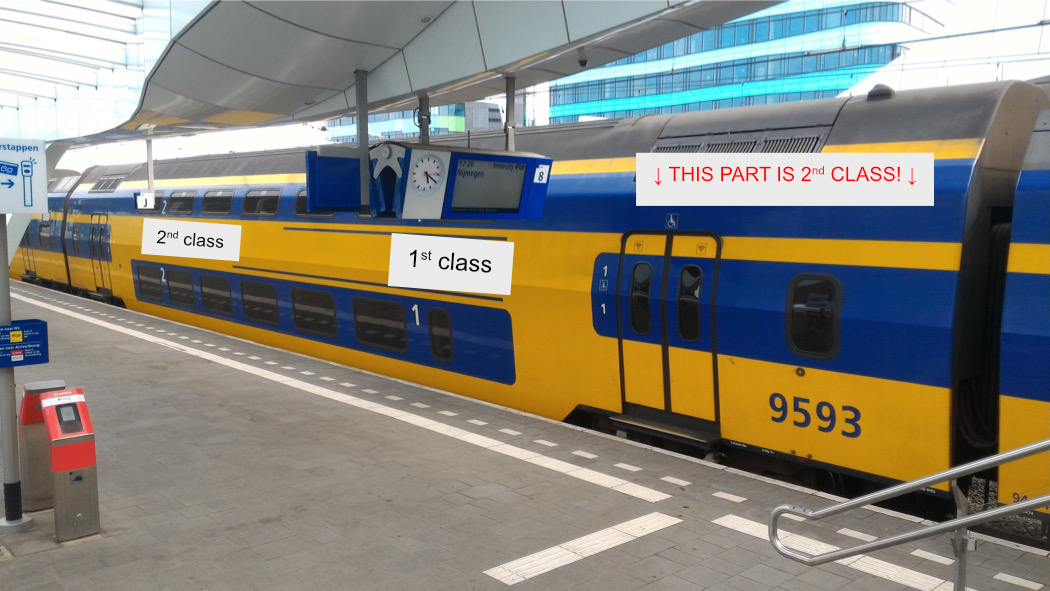
In the Netherlands, seats in the vestibule are always second class 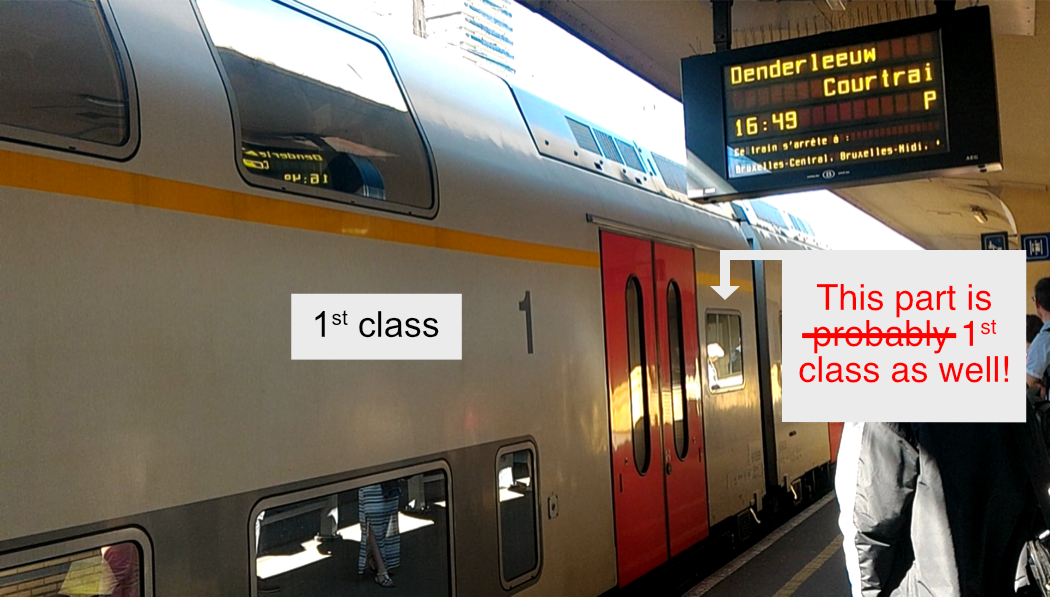
In Belgium, seats in the vestibule can be first class. The first class section is also marked by a yellow line on the exterior of the train - In some smaller trains, the first class seats are just a few seats at the very front or very back of the train, with or without a glass door separating those from the rest of the carriage. Some smaller trains have no first class seats.
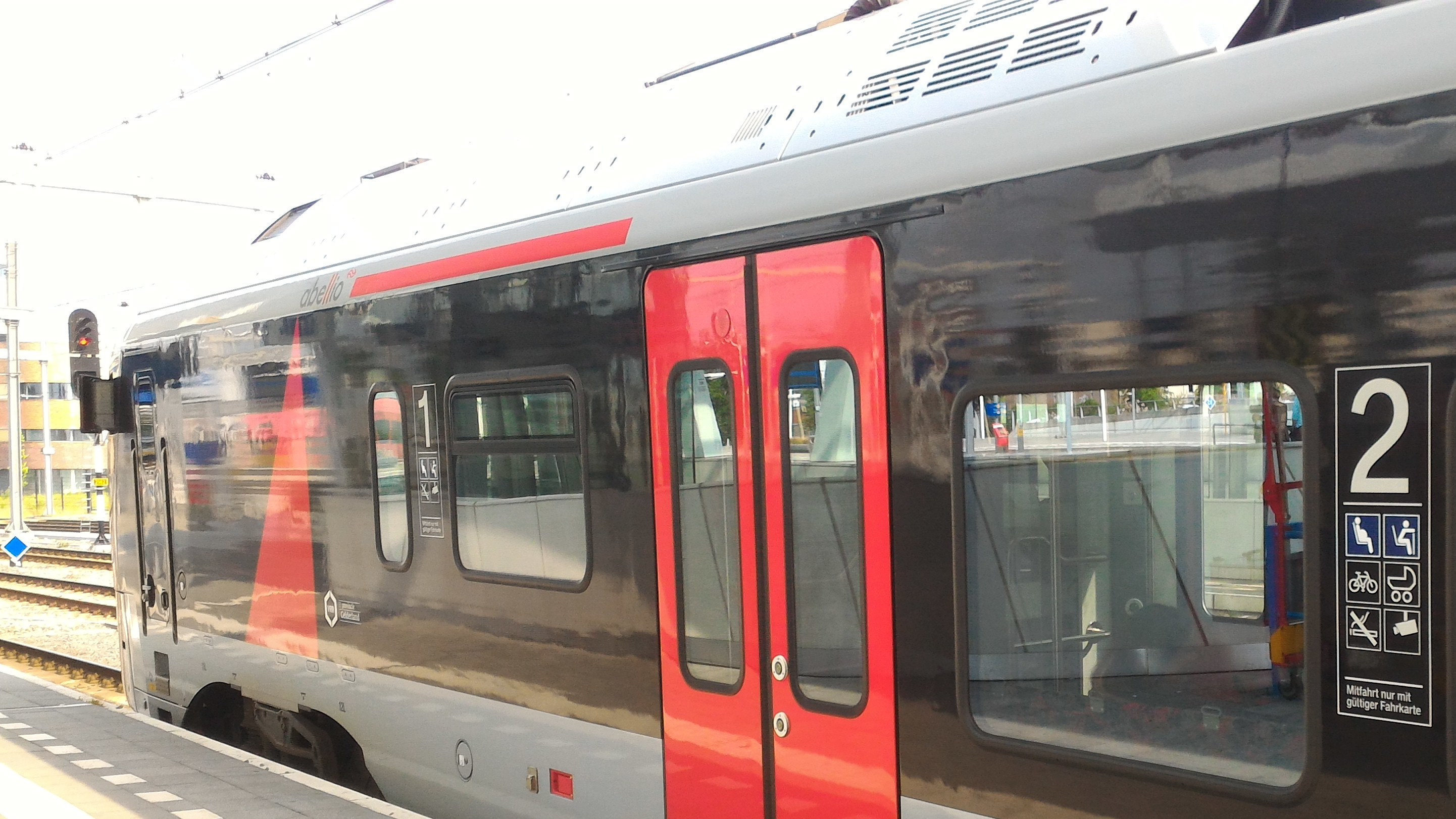
The 1st class section is at the end of this Abellio train 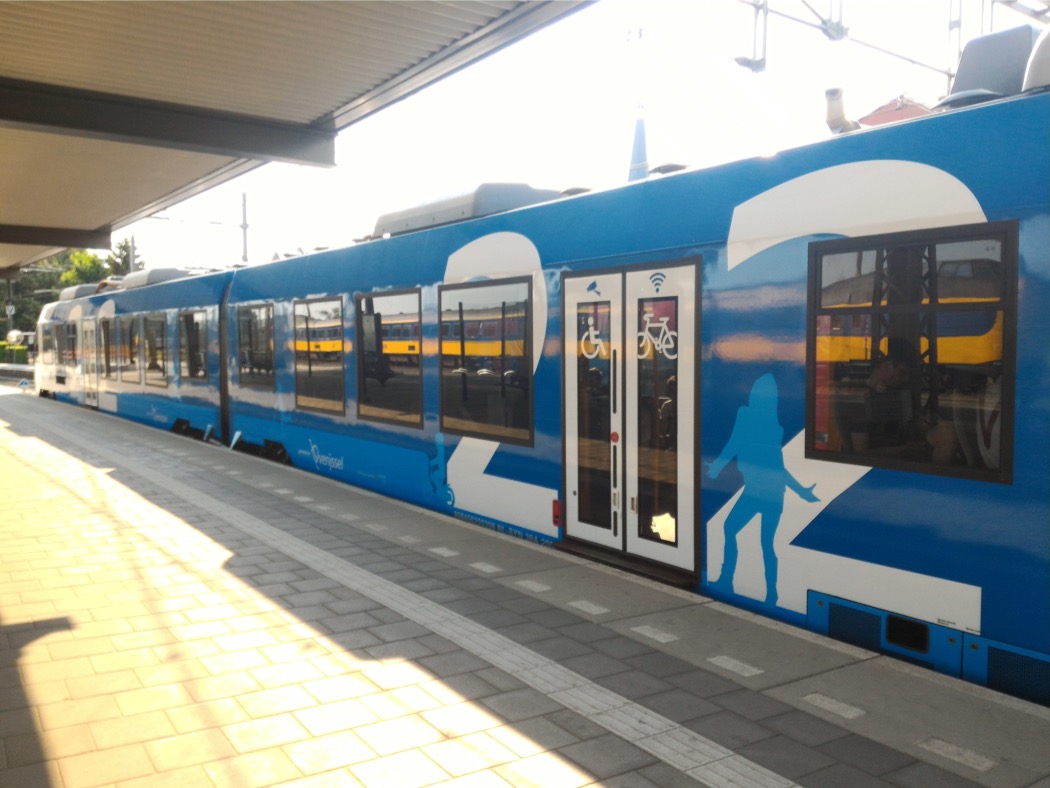
The jumbo 2s on Blauwnet trains in the Netherlands; this Zuthphen – Oldenzaal Keolis Blauwnet train has no first class seats - Having a ticket, either first class or second class, does not guarentee a seat. With a second class ticket, you can walk through a first class section to get to another second class section, but you are theortically not allowed to travel while standing in a first class section, not even when the second class sections are packed full of standing passengers. (This is the case in the Netherlands; I assume this is also the case in Belgium and Luxembourg. If in doubt, ask.)
- If you have a high-speed rail ticket, do not assume that you can automatically catch a slower train over the same trajectory if, e.g., you miss your designated high-speed train. For instance, if you have a Thalys or Eurostar ticket from Amsterdam to Brussels or further, DO NOT assume that you can therefore catch the slower Intercity direct to get to Brussels. After all, 1) a cheap Thalys/Eurostar ticket for Amsterdam–Brussels is cheaper than a full-fare Intercity direct ticket that you have to buy on the spot; and 2) NS (Dutch Rail) does not have shares in Thalys or Eurostar. Similarly, ICE in Belgium is run by NS (Dutch Rail) and DB (German Rail); if you have an ICE ticket from Brussels to Germany, DO NOT assume that you can use that ticket to catch a Belgian train (or a Thalys train) to Liège and spend some time there before catching your ICE train to Germany. If you miss your high-speed train, ask railway staff, they might be able to help you (e.g. your ticket might actually be flexible enough to allow changes even after the departure time). If it is a high-speed rail company's fault that you miss your train connection, they should be able to help you. (But don't count on them helping you if you miss your last possible connection. Accidents can happen; it is best to avoid having to rely on the last possible connection, or even the last few possible connections.)
- At major train stations there can be security checks before one boards a train, especially with high-speed trains in Belgium and France. Check the websites of the high-speed rail companies for security check arrangements. Arrive at the station/platform with ample time to spare.
- For Eurostar passengers going from Brussels to England, there is a check-in procedure, full-scale security check, Schengen immigration check, and UK immigration check at Brussels-Midi/Zuid ('Brussels-South'). (Customs check is conducted at arrival in UK. For Eurostar passengers going to just France, there is a separate check-in terminal at Brussels-South.) The Dutch and British governments have not yet come to agreement on British immigration and security arrangements at Amsterdam Centraal and Rotterdam Centraal, so for journeys from the Netherlands to London, Eurostar usually put customers on Thalys trains to get to Brussels-South first, where they go through immigration and security checks. Or you might choose to make your own way to Brussels-South first. In any case, get to Brussels-South with plenty of spare time if you catch Eurostar. See what Eurostar says about check-in time.
- Systematic checks have been abolished at the international borders within the Schengen Area. (Benelux, France, and West Germany were the original signatories of the Schengen Agreement in 1985.) Trains most usually run straight through the land borders between Benelux, France, and Germany. However, you could still have your ID and belongings checked by police or customs officers anywhere, including railway stations, or even inside moving trains. In special circumstances, systematic checks at the borders can be reinstated. Remember to have your passport or EEA/Swiss-issued ID card with you, and try avoiding tight connections in general.
Special trains
Not included in the maps above are charter trains from Benelux to, e.g., ski destinations in winter, music festivals in summer. (I know of Treinreiswinkel, and Festival.Travel.) Many of these charter trains are night trains.
The sleeper trains and auto trains from nearby places in 2018 are:
- ÖBB (Austrian Rail)'s Nightjet from Germany (Hamburg, Hannover, Düsseldorf, Cologne, Frankfurt, Berlin, Munich). Some ÖBB Nightjet trains can take vehicles. ÖBB is interested in running night trains to the Netherlands, and NS is interested in having the Nightjet service to Düsseldorf extended to Amsterdam. This service can start at the end of 2020 at the earliest.
- Urlaubs-Express from Hamburg and Düsseldorf to the south. Many take vehicles as well.
- Flixtrain's night train: Hamburg Altona – Hamburg Hbf – Hannover Hbf – Freiburg Hbf – Lörrach Autozug Terminal (near Basel).
- BahnTouristikExpress: Hamburg Altona – Lörrach Autozug Terminal. For vehicles and their drivers/passengers.
- РЖД RŽD (Russian Rail)'s Paris – Moscow night train: Paris-Est – Strasbourg – Karlsruhe – Frankfurt (Main) Süd – Berlin – Poznań – Warsaw – Brest – Minsk – Smolensk – Moscow Belorusskaya.
- SNCF (French Rail)'s Intercités de Nuit from Paris-Austerlitz. SNCF has a separate autotrain service from Paris-Bercy (no passengers).
- Thello of Trenitalia: night train between Paris-Gare-de-Lyon and Venice Santa Lucia
- Eurotunnel Le Shuttle auto train between Calais and Folkestone. (Motor vehicles can only cross the Channel Tunnel in this auto train.)
- Caledonian Sleeper between London Euston and Scotland.
- Great Western Railway's Night Riviera between London Paddington and Cornwall.
- Belmond's luxury trains.
You might also want to have a look at:
- Netherlands: the map of the printed timetables, map with train fare units, map with train series, list of train series at OV in Nederland wiki, train-spotter website SOMDA, information on international trains, location of trains in the Netherlands, another location of trains in the Netherlands. (The NS app also has a train tracker.)
- Belgium: the map of the printed line timetables in Dutch and French, the printed IC timetables in Dutch and French, the printed S timetables in Dutch and French, a larger map from Belgian Rail, list of train series at OV in Nederland wiki, train composition (Dutch, French), location of trains in Belgium. I learnt a lot from Arne Nys' Network map of the Belgian railways (2015). Information on international trains.
- Luxembourg: digital map and printed timetables for domestic and international services, train composition (Dutch, French), information on international tickets.
- France: official rail maps. Local train (and coach) map of Hauts-de-France, location of trains in France. Buses in France.
- Germany: local train maps of Niedersachsen, Nordrhein-Westfalen (or from here), and Rheinland-Pfalz (with Saarland) (or from here and press 'Liniennetzkarte'), location of trains in Germany, Elektronisches Kursbuch of DB.
- My pages on moving about in the Netherlands in general. (No need to go there if you're only interested in train travel.)
- Seat61.com: huge pool of knowledge on train travel in general.
Developments on train travels in Benelux since 10-12-2017:
- 01-01-2018: NRW-Tarif is now valid on RE 18 Heerlen – Herzogenrath.
- 14-01-2018: RB 61 starts operating between Hengelo and Bad Bentheim. (In reality, replacement buses run till Sunday 25-02-2018.)
- 12-02-2018: The station of Waddinxveen Triangel opens, on the Gouda – Alphen aan den Rijn line.
- 20-02-2018: Eurostar announces its London–Amsterdam schedule from 04-04-2018.
- 23-02-2018: NS announces that the non-peak surcharge-free period for Intercity direct is extended till 08-04-2018. (During this period, there is a surcharge for Intercity direct between Schiphol Airport and Rotterdam Centraal only between 06:30–09:30 and 16:00–19:00 on weekdays.)
- 28-03-2018: The station of Eemshaven opens; Eemshaven is now the northern-most train station in the Netherlands.
- 04-04-2018: Eurostar begins its operation in the Netherlands. However, border control in the Netherlands cannot start until at least the end of 2019. When passengers travel towards London, passengers have to disembark and go through Schengen and UK border controls in Brussels. The train towards London stops at Brussels for 1 hour 18 minutes; Eurostar usually put passengers on Thalys trains to get to Brussels.
- 09-04-2018: IC Amsterdam – Brussels rerouted to high-speed rail lines, and becomes Intercity direct (ICd). (In the few months before this, nearly all trains terminated at Den Haag Hollands Spoor instead, running only on non-high-speed rail lines.) 12 trains per day run through the Schiphol–Rotterdam high-speed line to/from Amsterdam (these are now classed as Intercity direct in the Netherlands), while 4 trains per day goes to/from Den Haag HS (these remain InterCity; 1 of these per day continues to/from Schiphol and Amsterdam on conventional rail). Dordrecht and Roosendaal are now skipped, while Breda and Noorderkempen are added. The ICd surcharge (between Schiphol and Rotterdam) is €2.40, or €1.40 if paid through the ICd surcharge protals on platforms during off-peak.
- 09-04-2018: Replacement buses for the P/RE trains no longer run between Gouvy and Troisvierges.
- 26-05-2018: L train service between Roosendaal and Puurs disconnected at Essen. This lasts till late August(?).
- 10-06-2018: Major changes in Belgium:
- The weekday Mons – Quévy L-service is detached from the La Louvière-Sud – Mons L-service, and attached to the Mouscron/Tournai – Mons L-service.
- The line 125A is served by passenger trains again, with the new stations of Seraing and Ougrée: a) new hourly L-service everyday between Flémalle-Haute and Liers; b) the hourly Waremme – Liège-Guillemins L-service is extended to Flémalle-Haute during weekday peak time in both directions.
- The Charleroi-Sud – Antwerpen-Noorderdokken IC makes an extra stop at Antwerpen-Luchtbal.
- Wildert now served by both L-services on this line; Wildert now has two instead of one train service per hour in each direction.
- Two extra P-services from Noorderkempen in the morning, one to Anterwpen-Centraal, one to Brussels Airport-Zaventem. Both skip Antwerpen-Luchtbal.
- The Kortrijk – Welkenraedt IC has less services between Leuven and Welkenraedt.
- Other timetable changes.
- 16-06-2018 (night of 15-06-2018): Nachtnet trains stop at both directions at Elst, instead of just towards Nijmegen.
- 27-08-2018: The Enschede – Raalte IC is extended to Zwolle.
- 03-09-2018:
- Near Liège: the station of Chaudfontaine to the east reopens; the stations of Liège-Jonfosse and Liège-Palais are renamed Liège-Carré and Liège-Saint-Lambert [Luik-Sint-Lambertus] respectively
- Many L-lines are now S-lines; around Antwerp are S32, S33, S34, around Liège are S41, S42, S43, S44, around Gent are S51, S52, S53, around Charleroi are S61, S62, S63, S64.
- The station Leeuwarden Achter de Hoven is closed permanently.
Disclaimer
I do this as a hobby. I am not a travel agent; while I would be interested in questions that you might have, please direct your questions to the public transport providers involved. Situations and rules can change quickly; please check with the public transport providers for the latest information. I take utter care on the accuracy of the information I provide here, but I cannot be held responsible for any inaccuracies. If you see any doubtful information, comments are welcome: hilario.bambooradical gmail.
Unless otherwise stated, all diagrams, photos, and videos are work of mine. Please respect copyright. I apologise for the quality of the photos and videos; I hope that they are good enough for illustrative purposes.
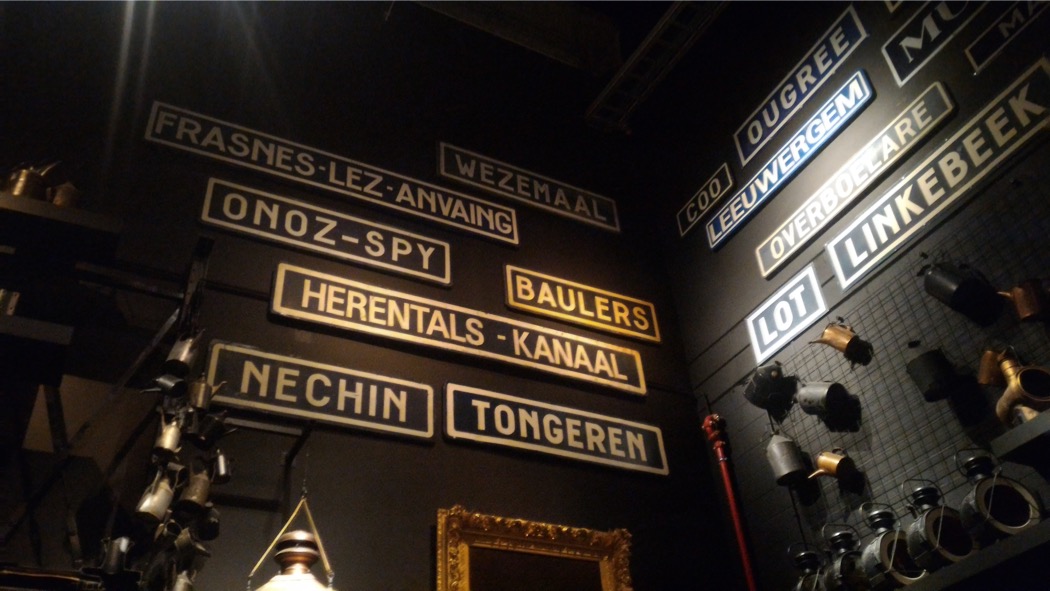
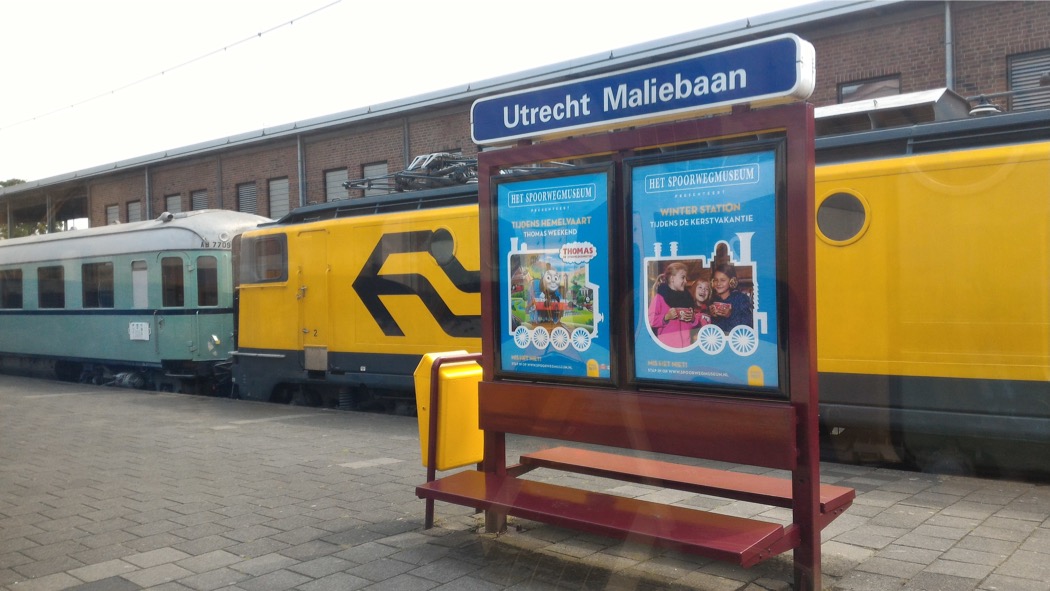
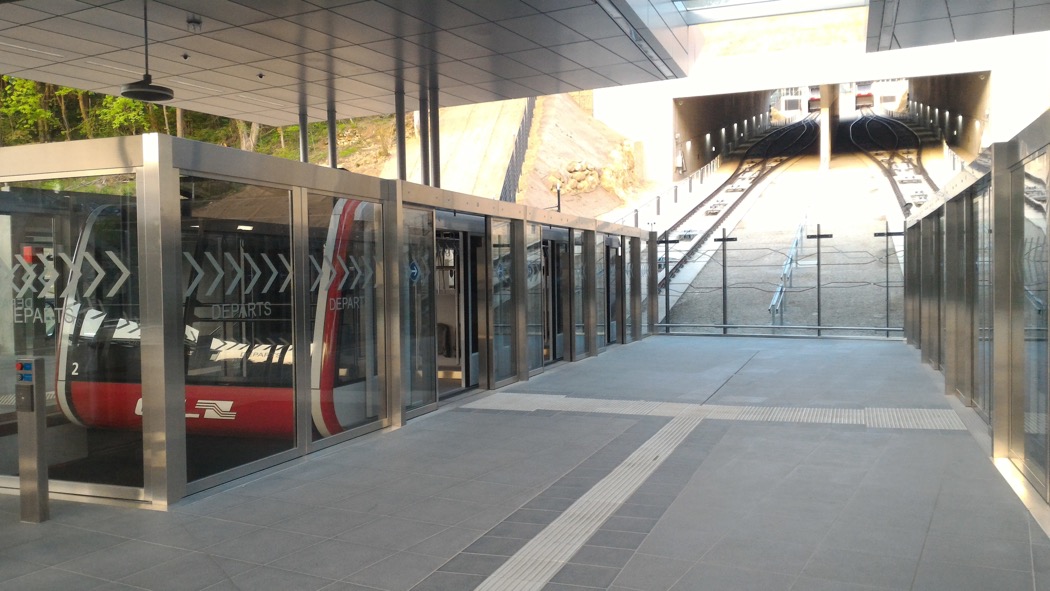
This page in 2019
Home Be Ne Lux
